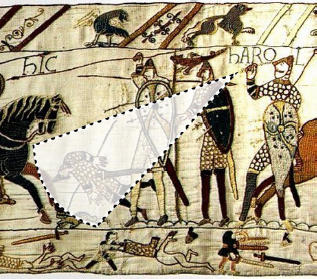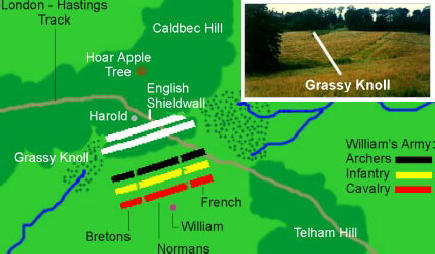The Death of Harold Godwinson
On October 16th, 1066, King Harold of England was killed, by all accounts, by an arrow shot into his eye. After this point, accounts diverge; some claim he was trampled by a horse; others state he was hacked to pieces by swords; still more assert he was run through by William the Conqueror's lance.
But who fired the arrow? The Bayeaux Tapestries provide us with a clear picture of the event, and if we follow the trajectory of the arrow to its likely origin, no evidence of an archer can be found.

Notice that we cannot see the entry point; the arrow must therefore have struck him on the right side of his head. Elementary physics teach us that, upon impact, Harold's head would have then snapped back and to the left (the viewer's right).
Tracing a cone of probable trajectories backwards (at right), we can observe that there is no archer depicted at any point from which the arrow could have come. This indicates that additional investigation is necessary to determine the actual killer of King Harold.
The Guardian, a British newspaper, recently published the results of Lord Hutton's investigation into the affair; Hutton concluded that Harold had not been killed by William's forces, but that he and 12,472 of his followers had simply committed suicide. (http://www.guardian.co.uk/hutton/story/0,13822,1146756,00.html)
This interpretation of events, in this researcher's opinion, strains credibility to the breaking point. In one or two accounts, a Norman archer named Lea Hervé is identified as the marksman responsible, but the Tapestries show no evidence of Hervé at the critical juncture. There must, therefore, have been some second bowman, not visible in the scene from the Bayeaux Tapestries, yet still somewhere within the cone of trajectory.
Breaking out of the two-dimensional scene depicted by the Tapestries, we look at an overhead view of the battle at Caldbec Hill. In the view shown of Harold's death, the Normans are in the left of the scene, and the Saxons to the right. This therefore puts the observer to the east of the battle, looking westward. Referring to the map (below), we discover that to the west of the scene was a grassy knoll (inset). Were the second bowman hidden low enough behind the grassy knoll, he might easily have escaped the notice of the Tapestry's creator.

Clearly, this solves the mystery of where the shot came from — for an arrow coming from this direction would still have snapped Harold's head back and to the left — but not the identity of the killer.
For all we know, it need not have been one of William's men, for the probable location is congruent with, if not behind, the line of Harold's defenses. Was it a conspiracy within Harold's own forces? Certainly his policies had not been well-received by all his people; perhaps one or more of his own archers was collaborating with the enemy in hopes of bringing about a different regime.
Or perhaps it was the Church, which had received many troubling reports about the Saxon violence plaguing England. Another possibility is the criminal underworld, who had recently suffered financial losses due to the increase in shire Reeves under Harold's reign.
Whatever the answer, it is clear that the Bayeux Tapestries do not show a complete picture of the events that October day. The truth is out there, if you look hard enough for it.
